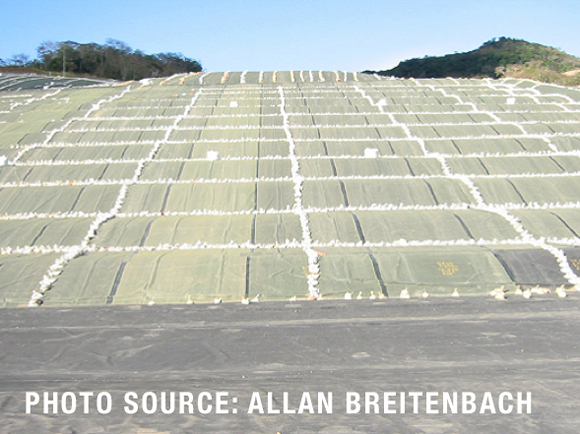


Mining operations continue to scale up, achieving previously thought “impossible” designs every few years. These engineering feats enable new impossibilities to be proposed. While heap leach engineering and technology is driving much of the escalation in mining scale, a rather simple solution is helping make these installations safer and more efficient—which is to say more profitable: raincoats.
Raincoat liners are not new, but they haven’t enjoyed a lot of interest historically. They have the feel of something so sacrificial that they are generally not considered critical. But they can provide strong ROI and environmental performance for a mine.
Functionally, their primary purpose is to shed precipitation. They act as a tarp. This prevents the leach heap from being diluted with stormwater. If stormwater dilutes the leached material, the pregnant liquor flowing from a leach pad may require more processing (ie, be less efficient and more costly) and extra stormwater treatment and storage may be needed on site (meaning, more cost and environmental risk).
A raincoat liner, selected in accordance with the chemical compatibility needs of the site’s leaching operation, can be an affordable, easily implementable strategy to shed clean stormwater without the need for treatment and detention.
SEE ALSO: Geosynthetics in Mining Applications: Containment
SCALING UP
In 2013, engineer Monte Christie helped turn up the dialogue on geomembranes in mining by revealing that up to 40% of the global annual production of geomembranes was being used by mining. Much of this was in regards to heap leach.
Christie’s comments and a presentation at the Geosynthetic Research Institute (GRI) 25th symposium were excellently timed, building upon articles, presentations, and keynote addresses by other well-known and respected engineers with strong backgrounds in geosynthetics and mining. These figures include Mark Smith, Alan Breitenbach, Richard Thiel, and Mike Sadlier.
The body of literature and field experience shared by these engineers have helped underscore how such a dramatic usage of geomembranes was possible in mining alone, despite little attention to the work at mining industry events:
- Commerical-scale operations began to use raincoats in 2000s
- Chalcopyrite copper began to be heap leached
- Uranium began to be heap leached on a significant, commercial scale
- Heap leaching of copper and gold has risen from 3% of production in 1990 to more than 30% of production today
- Engineers have even achieved heap leaching of rare earths, which are dearly important to smartphones and tablets
Additional factors, such as the rise of water costs at mines—stormwater treatment, freshwater storage, pumping of water to/from sites—have also factored into the need to achieve more efficient, more immediate yields.
SEE ALSO: Floating Covers, Evaporation, and Mine Economics
Geosynthetics, and particularly geomembranes, have been integral to controlling costs and producing quicker yields.
THINNER GEOMEMBRANES TRENDING
Many designers now specify 1.5 mm high-density polyethylene (HDPE) geomembrane for raincoat liner designs, but thinner geomembrane (e.g., 1 mm) are generally selected due to their more attractive price point.
And price point is a major factor in mining. On a USD $2 billion heap leach operation, the price difference between a 1 and 1.5 mm geomembrane becomes significant over hundreds of acres of development. If the thinner geomembrane will quickly pay for itself in saving cost in other areas—e.g., less of a stormwater storage footprint requirement—the thinner geomembrane is far more likely to be selected for a raincoat liner, even if slightly more secure yields can be achieved under the protection of a 1.5 mm geomembrane.
Also, a geomembrane, in even large volume, is only a small line item in a mine’s expense. Outside of any regulatory compliance issues, its cost does not merit—from the mine construction perspective—too much time. It is upon the design engineer with geosynthetics experience to make adjustments and recommendations to optimize the design within the cost constraints.
In short, whatever will produce more economical and quicker construction and enable a mine to go into production sooner has the advantage.
SEE ALSO: Geomembranes in Mining: The State of Research











